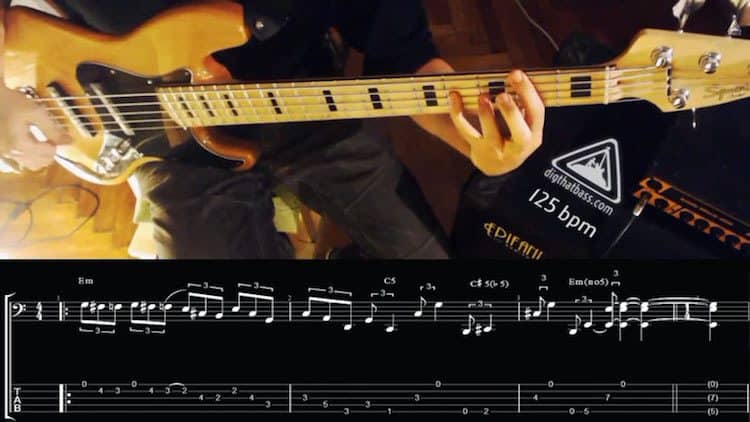Bass Edu
Evan Mariens Eternals and Apathetics

Bass Lesson, Evan Marien’s Eternals and Apathetics…
I remember finding the first videos of Evan Marien on YouTube and I was amazed from the first moment. I found that while he is one of the pioneers who steps out of the ‘traditional’ bass role, and keeps pushing the boundaries of music by exploring the world of electronica and effects, he still has melody at the heart of his playing. I really love how he is simplistic and complex at the very same time, and i really think you can learn a lot just by listening to his music. Evan recently decided to release educational videos on his channel, check him out, it is very worthwhile!
So, this time we go quite technical on the 5 string, you’ll probably have to sit down for weeks to get this under your fingers! Eternals and Apathetics is an improvisational piece and it is played freely as well I chose this little intro riff-kinda-thing since it stuck in my ears, and i really wanted to learn it ….but during learning it, i noticed that besides being technical it really makes you think about every single note and in that sense it is quite a musical lesson as well. I’ll hope you’ll get what i mean when you learn it 😉
The riff incorporates the usage of the open G string – you really have to pay attention to it, it should not stand out, it should not be choked (like i did once on the slow version) It should be flowing – begin slow, and gradually build up speed so your left and right hand can learn to co-operate perfectly. The chords are played with three fingers (thumb-index-middle)
As it is a free piece, harmony is approximate, i did my best, better ask Evan about the exact ones 😉 The time signature is also kind of tricky, but for the sake of simplicity, the notation shows you a time signature of 4/4 and every fourth bar there is a 1/4 bar. So here’s how you should think about it – the metronome is set on straight 4s, and when you picked the last G note in the third bar, you should hold it for two fourth notes, and then it begins again. More simply, after you picked that G note, cound together with the metronome 1…2.. and on 3, the line begins again. Dig? 🙂
So have fun, if you have any questions or requests, shoot!
The video does not intend to violate any laws or copyrights, it is to be used for educational purposes (fair use). The original song is available for purchase and listening at:
itunes.apple.com/us/album/ete…
evanmarien.bandcamp.com/album/…
youtube.com/watch?v=vU8O5E…
Bass Edu
BASS LINES: Triads & Inversions Part I

Triads & Inversions Part I…
Hello bass players and bass fans! In this issue, we are going to study the triads and their inversions.
It is very important for all bassists to understand and master the triads, but it is even more important to understand their different inversions.
In Part I, we are going to learn what the triad is in fundamental position.
The Formula consists of root, third and fifth.
Degrees of the Triad
Major Triad: 1 – 3 – 5
Minor Triad: 1 – b3 – 5
Diminished Triad: 1 – b3 – b5
Augmented Triad: 1 – 3 – #5
Fig.1 – The C, Cm, Cdim & Caug triads
(Fundamental Position)
Bass Edu
Premiere! Bass Playthrough With Foetal Juice’s Bassist Lewis Bridges – From the Album, Grotesque

Premiere! Bass Playthrough With Foetal Juice’s Bassist Lewis Bridges – From the Album, Grotesque
Bassist Lewis Bridges Shares…
“Gruesome’s sparse intro marks a stark contrast from the intensity of the rest of the album. The original intention was to keep the bass simple but colourful, however as I worked on it, the lines grew more expressive and the more striking flourishes began to emerge. The intensity builds into a harmonic minor passage that takes us into the drop — a signature death grind cacophony. This is where Foetal Juice thrives. You’re getting a full-on right-hand barrage to in the face to take you into a groove-laden mulch-fest.
I owe my throbbing bass tone to the Darkglass Alpha Omega pedal borrowed from our sound engineer, Chris Fielding (ex-Conan), mixed with the clarity of the tried and true Ampeg SVT CL.
As mentioned earlier, colourful basslines are important, especially in a one-guitar band. Chucking some funny intervals and odd flourishes here and there brings life into the brutality. There’s no point sounding brutal if it’s not gonna be fucking evil too!
Recording this playthrough was hard work. This was not the fault of James Goodwin (Necronautical), who was kindly filming and is ace to work with, but because in true Foetal fashion, we had stinking hangovers — and that jam room was hot!”
Follow Online
FB @FoetalJuice
TW @FoetalJuice
IG @foetaljuice
Youtube: @Foetaljuice
Spotify
Foetaljuice.bandcamp.com
Bass Edu
Bass Lines: The Circle

Bass Lines: The Circle…
Hello bass players and fans of bass! This month we’re going to study “The Circle.”
The Circle of Fourths can also be called “The Circle of Fifths or just The Circle.
Practicing the scales, chords, and ideas in general via the circle has been a common practice routine for jazz musicians and highly recommended.
It is a disciplined way of working through all twelve keys.
Plus, many bass root movements to jazz and pop songs move through sections of the circle.
Fig. 1 – “The Circle”

See you next month for more full bass attack!
#bassmusicianmag, #basslines, #bmmbasslines, #groovemaniac, #thecircle, #thecircleoffourths, #thecircleoffifths,#scales & #chords.
Bass Edu
Approach Notes – Part 5

Continuing our lesson of Approach Notes, Part 5…
In continuing with the concept of approach notes being applied to chord tones, this lesson approaches the root, third, fifth, and seventh degree of each arpeggio inversion by incorporating a double chromatic approach from above, and a single chromatic approach from below.
The first examples approach the root of a G major 7th arpeggio as a double chromatic from above and a single chromatic approach from below -before continuing to the third, fifth, seventh, double chromatic from above/ single from below to the root, continue to the third, fifth, and come back down.
The next example approaches the first inversion of G major 7th arpeggio.
A double chromatic from above/ single from below approaches the third, continue to the fifth, seventh, root, double chromatic from above/ single below to the third, continue up to the fifth and seventh, and back down.
The third example approaches a second inversion of a G major arpeggio.
A double chromatic from above/ single from below approaches the fifth, continue to the 7th, root, 3rd, double chromatic from above/ single from below to the 5th, continue to the 7th, root, and back down.
This final example approaches a third inversion of a G major 7th arpeggio.
A double chromatic from above and below approaches the 7th, continue to the root, 3rd, 5th, double chromatic from above and below to the 7th, continue to the root, 3rd, and back down.

Be sure to pace yourself with these lessons to avoid burning out.
Being overly ambitious with your practice schedule can lead to unrealistic expectations. Try learning one approach note concept and one chord type a week. Change your practice routine as necessary and tailor it to your needs as a musician. Good luck!
Bass Edu
BASS LINES – The Blue Notes (Minor Blues Scale)

Hello bass players and bass fans! Happy New Year 2024!
In this issue, we are going to study the blue notes.
In blues, jazz, and rock, a blue note is a note that (for expressive purposes) is sung or played at a slightly different pitch from standard. Typically the alteration is between a quartertone and a semitone, but this varies depending on the musical context.
The blue notes are usually said to be the lowered third(b3), lowered fifth(b5) and lowered seventh(b7) scale degrees. The lowered fifth(b5) is also known as the raised fourth(#4). Though the blues scale has “an inherent minor tonality, it is commonly ‘forced’ over major-key chord changes, resulting in a distinctively dissonant conflict of tonalities”.
Blue notes are used in many blues songs, in jazz, rock and in conventional popular songs with a “blue” feeling.
Formula:
The A Minor Blues Scale
1 – b3 – 4 – (#4/b5) – 5 – b7
A – C – D – (D#/Eb) – E – Bb
The grades(blue notes):
b3, (#4/b5), b7
C, (D#/Eb), Bb
See you next month for more full bass attack!
#bassmusicianmag, #basslines, #bmmbasslines, #groovemaniac, #thebluenotes, #minorbluesscale & #bluesscale













